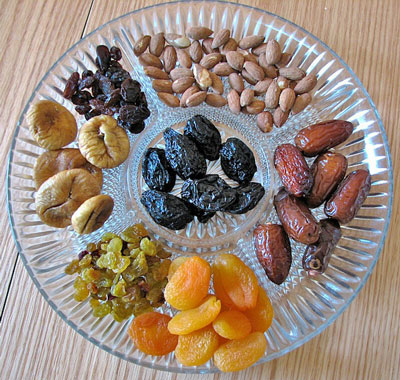Tu Bshvat Traditional Food Products
2015 Jun 21st
Every January Jews around the world stock up on a selection of traditional grains, fruits, nuts and honey for traditional Tu B’Shvat meals. The Tu B’Shvat meal celebrates the New Year of Trees and effectively the start of spring in Israel.

Traditionally seven foods are served for Tu B’Shvat because seven is considered a sacred or complete number in the Torah. Each ingredient of the traditional feast carries deep meaning and connects Jews to their cultural and religious heritage. The seven traditional ingredients and their meanings are:
Wheat or Hittah represents survival and connection between nourishment and the ability to grow spiritually through study. Wheat is a staple of life and the key ingredient of bread, crackers and other basis foods. Without basic food for the body it is impossible to survive. If survival is threatened, the needs of the body take over and make it impossible to feed the mind.
Barley or Se’orah represents appreciation. Like wheat, barley is a staple grain. Barley is often undervalued and does not receive the same appreciation as wheat. Therefore, barley reminds the Jew to appreciate the under appreciated and remember the important things in life that they might forget.
The Grape or Gefen represents community for grapes grow in interdependent clusters on a vine. Being firmly connected to the community and each other, like grapes are firmly connected to the vine and each other, is critical to our well being. Tu B’Shvat meals usually include dried raisins and grape wines.
The Fig or Te’enah represents theTorah. Most fruits have some inedible parts but the whole fig is good to eat. Likewise the whole Torah is good to study and sweet to the reader like a fig.
Honey or D’vash represents concern for living things. Honey is the product of the honey bee, one of the hardest working yet most humble of creatures. The honey bee and honey remind the Jew to respect and care for all living things. Respect for creation should extend from our fellow man down to the lowly honey bee.
Pomegranate or Rimon seeds represent the 613 commandments in the Torah and remind the Jew to keep those commandments. Pomegranates also featured in the Jewish High Priest’s garments as a reminder for Jews to be fruitful and multiply.
The Olive or Zeit Shemen represents hope for the future and peace. Genesis tells us that at the end of the flood, Noah sent forth a dove from the ark and that on the second trip the dove returned with an olive branch in its beak. This dove and the olive branch it carried have come to symbolize peace and hope for a better world. For example, olive branches and doves are featured on the United Nations logo and a number of country flags to symbolize peace and hope. In English the phrase “to extend an olive branch” means to offer peace.
As Jews share these traditional foods with family and guests over the Tu B’Shvat meal, they should remember to discuss the symbolism of the seven ingredients. Each person should contemplate applying the lessons contained in the symbolism of the meal ingredients to improve their relationships with God and those around them.

